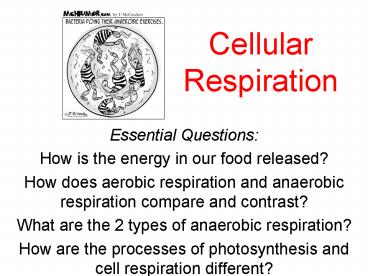Cellular Respiration - PowerPoint PPT Presentation
Title:
Cellular Respiration
Description:
Cellular Respiration Essential Questions: How is the energy in our food released? How does aerobic respiration and anaerobic respiration compare and contrast? – PowerPoint PPT presentation
Number of Views:158
Avg rating:3.0/5.0
Title: Cellular Respiration
1
Cellular Respiration
- Essential Questions
- How is the energy in our food released?
- How does aerobic respiration and anaerobic
respiration compare and contrast? - What are the 2 types of anaerobic respiration?
- How are the processes of photosynthesis and cell
respiration different?
2
Cellular Respiration
- Cellular Respiration Process by which
mitochondria break down food molecules to produce
ATP - Does not use Oxygen is called Anaerobic
- Does use Oxygen is called Aerobic
- There are 3 stages of Cellular Respiration
- 1) Glycolysis (Anaerobic)
- Citric Acid Cycle (Aerobic)
- Electron Transport Chain
- (Aerobic)
3
(No Transcript)
4
Glycolysis - Anaerobic
- Glycolysis series of chemical reactions in the
cytoplasm of a cell that break down glucose (a 6
Carbon compound) into 2 molecules of pyruvic acid
(a 3 Carbon compound) - NAD accepts a pair of high energy electrons to
pass that energy to other pathways in the cell. - 2 Molecules of ATP are used to start Glycolysis
and only 4 ATPs are produced - Net only 2 ATP
- Then pyruvic acid proceeds to the Mitochondria to
begin the Citric Acid Cycle and the Electron
Transport Chain (in the presence of Oxygen)
5
Anaerobic Processes
- Sometimes your cells are without Oxygen for short
periods of time (during strenuous exercise, etc) - In order to make ATP, the process of Fermentation
occurs after Glycolysis until Oxygen becomes
available again. - During fermentation, cells convert NADH to NAD
by passing high energy electrons back to pyruvic
acid. This action converts NADH back into the
electron carrier NAD allowing glycolysis to
continue producing a steady supply of ATP. - Some organisms simply live in areas without
Oxygen and must produce their ATP this way. - http//www.youtube.com/watch?vy_k8xLrBUfg
6
2 Anaerobic ProcessesLactic Acid Fermentation
Alcoholic Fermentation
- Without Oxygen, the Electron Transport Chain
becomes backed up since no Oxygen is there to be
the final electron acceptor - Pyruvic Acid NADH ?
- lactic acid NAD
- Lactic Acid is the cause of sore muscles.
- Certain organisms living in anaerobic
environments will rely on this type of ATP
synthesis. - Pyruvic acid NADH ?
- alcohol CO2 NAD
- Yeast use this type of fermentation to create C02
and ethyl alcohol.
7
(No Transcript)
8
Aerobic Respiration
- Most efficient type of Cellular Respiration!
- Requires Oxygen
- Occurs in 3 steps
- 1) Glycolysis
- 2) Citric Acid Cycle
- 3) Electron Transport Chain
- Glycolysis is the only step that is Anaerobic.
- The other Anaerobic process was fermentation.
9
Aerobic Respiration - Mitochondria
- Remember, Glycolysis breaks down 1 glucose into 2
pyruvic acid molecules - Heads to Mitochondria for Aerobic Respiration
- Citric Acid Cycle occurs in the outer
mitochondrial membrane - Calvin Cycle glucose was formed
- Citric Acid Cycle glucose is being broken down
- For 1 Glucose molecule, 1 ATP is made for every
turn of the cycle. - http//www.wiley.com/college/pratt/0471393878/stud
ent/animations/citric_acid_cycle/index.html
10
Electron Transport Chain 12
- Very Similar to the ETC of the thylakoid in
plants! - NADH and FADH2 pas energized electrons from
protein to protein releasing small amounts of
energy. - A Concentration gradient forms in the
mitochondria - Hydrogen ions inside
- Lack of Hydrogen ions outside
- An Electrical gradient forms in the mitochondria
(H ions pumped inside) - Positive in the center
- Negative on the outside
11
Electron Transport Chain 22
What type of protein am I?
- The final electron acceptor is Oxygen
- Yields Carbon Dioxide (CO2), 2 Water, and 36 ATP
- Most efficient process since anaerobic
respiration only yields 2 ATP. - http//www2.nl.edu/jste/electron_transport_system.
htm
An Enzyme!
12
Overview of Cellular RespirationLabel the
picture on your notes!
13
(No Transcript)
14
Comparing Photosynthesis Respiration
- PHOTOSYNTHESIS
- Food accumulated
- Energy from the Sun stored in Glucose
- CO2 taken in
- Oxygen given off
- Produces Glucose from PGAL
- Goes on only in Light
- Occurs in the presence of Chlorophyll of Plants
only - Chloroplasts
- RESPIRATION
- Food Broken Down
- Energy of Glucose Released
- CO2 given off
- Oxygen taken in
- Produces Carbon Dioxide, Water ATP
- Goes on Day Night
- Occurs in all Living Cells (Plants and Animals)
- Mitochondria































